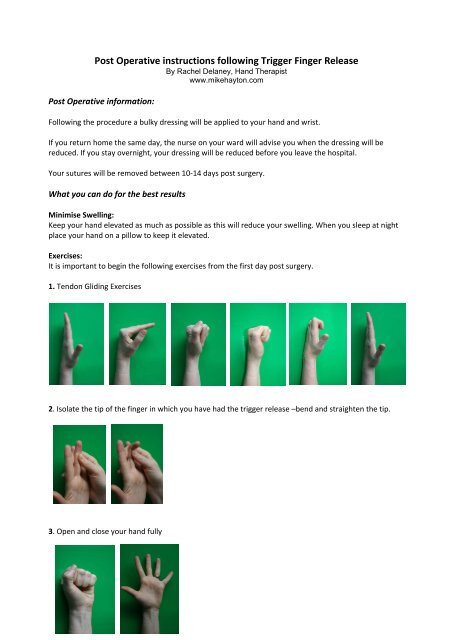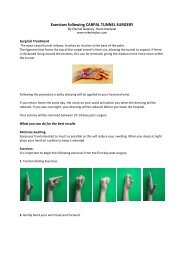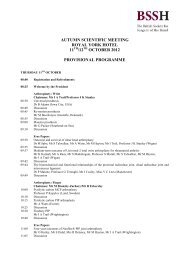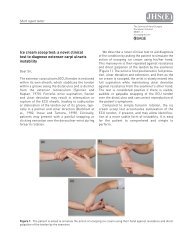Post Operative instructions following Trigger Finger ... - Mike Hayton
Post Operative instructions following Trigger Finger ... - Mike Hayton
Post Operative instructions following Trigger Finger ... - Mike Hayton
Create successful ePaper yourself
Turn your PDF publications into a flip-book with our unique Google optimized e-Paper software.
<strong>Post</strong> <strong>Operative</strong> <strong>instructions</strong> <strong>following</strong> <strong>Trigger</strong> <strong>Finger</strong> Release<br />
By Rachel Delaney, Hand Therapist<br />
www.mikehayton.com<br />
<strong>Post</strong> <strong>Operative</strong> information:<br />
Following the procedure a bulky dressing will be applied to your hand and wrist.<br />
If you return home the same day, the nurse on your ward will advise you when the dressing will be<br />
reduced. If you stay overnight, your dressing will be reduced before you leave the hospital.<br />
Your sutures will be removed between 10-14 days post surgery.<br />
What you can do for the best results<br />
Minimise Swelling:<br />
Keep your hand elevated as much as possible as this will reduce your swelling. When you sleep at night<br />
place your hand on a pillow to keep it elevated.<br />
Exercises:<br />
It is important to begin the <strong>following</strong> exercises from the first day post surgery.<br />
1. Tendon Gliding Exercises<br />
2. Isolate the tip of the finger in which you have had the trigger release –bend and straighten the tip.<br />
3. Open and close your hand fully
All of these exercises should be done 3-4 times a day. Do 5-10 repetitions each.<br />
None of the exercises should be significantly painful, although you may initially experience a little<br />
discomfort.<br />
Scar:<br />
Once your wound is completely closed and the sutures have been removed, begin massaging your scar<br />
and the surrounding area with lotion. Any non perfumed hand cream will be suitable. The massage will<br />
help soften your scar, decrease sensitivity and promote healing.<br />
Activity and Use of your Hand:<br />
You may begin using your hand for light tasks, e.g. dressing, eating etc. as soon as pain allows (however,<br />
remember to keep your dressing clean and not to immerse your hand in water until your sutures have<br />
been removed). Over time, slowly begin to use your hand more and for other tasks as tolerated.<br />
By 2 weeks post surgery you should be able to use your hand for most normal day to day tasks.<br />
You are able to drive as soon as pain allows and you are safe to control the vehicle.<br />
It is very important not to overuse your hand <strong>following</strong> surgery, as this may delay your healing. If, after<br />
using your hand in daily activities, your notice a significant increase in your pain or swelling you should<br />
reduce your activities until your hand recovers.<br />
What to look out for:<br />
If you experience any of the <strong>following</strong> symptoms in the weeks <strong>following</strong> surgery, please contact your<br />
surgeon or therapist:<br />
Persistent pain, swelling or scar sensitivity<br />
Significant stiffness in the wrist and fingers<br />
Inability to straighten your fingers fully<br />
Inability to use your hand for daily tasks.<br />
Rachel Delaney<br />
Rachel@hand-therapy.co.uk<br />
Appointments: 0161 495 7000





